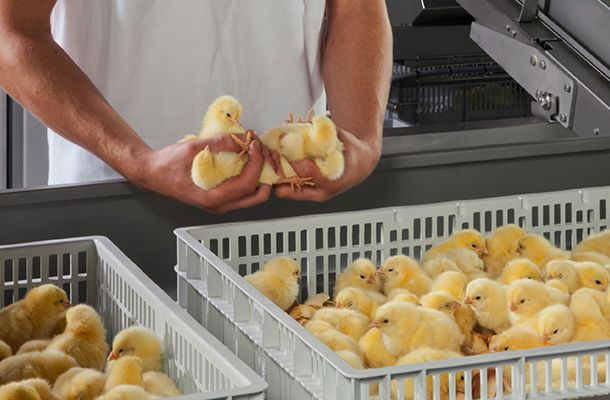Evaluating chick quality
Tags: Chick handling | Whitepaper
, October 12 2020

The term "chick quality" is rather vague, as it can refer to various aspects – from directly visible physical traits to hidden ones, such as antibody levels, physiological disorders, infections and nutritional deficiencies. Many of these originate long before the eggs reach the hatchery. Environmental conditions and time can have a detrimental effect on chick quality. A chick-quality score is only a reflection of a temporary status and an expression of current prospects for the farm results.
The hatchery’s legal responsibility is usually limited to the first week of a chick’s life – a sensitive period, when development is its fastest. A good, smooth start is essential and determines the final result. As time passes, farm-related factors start to prevail over those of the hatchery. Nevertheless, vertically transmitted diseases found later on may still adversely affect the hatchery's reputation.
From the hatchery's perspective, a good day-old-chick is free from physical disorders, and shows the following traits: strong, standing on its legs; fluffy (including standing fluff on the head); active but relaxed; clean; open, round eyes; soft, supple belly; well-closed, invisible navel; not bony; not dehydrated; free of injuries and deformations.
These traits are related to and correspond with different aspects of incubation and hatchery procedures. While a trait score can have a wide range (e.g. to describe the size of belly or level of fitness), it is best to minimise subjectivity and simplify assessment to a 0/1 system. Either the trait is correct or not.
Today’s hatchery business is a mass operation processing thousands of chicks per day. A daily hatch frequently consists of many sub-groups (based on flock, age, egg age). A quality control system must be comprehensive, quick, easy and repeatable. It should enable batches to be compared and provide a numerical expression of quality.
An example is the Pasgar©Score, based on 5, easy to evaluate, traits. Some of them, like a red beak or hocks, may seem cosmetic but actually indicate serious problems.
- A strong, well-shaped chick will right itself within 3 seconds if placed on its back on a flat, non-slippery surface. This ability, which is a reflex, is an indication of its general fitness.
- The navel should be well closed and invisible. A navel that is dry and skin-coloured but convex and rough to the feel is not correct; but it is a lot better than a leaking or hyperaemic navel. Following the principle of 'correct or not', both forms will score negative.
- Evaluation of the belly – its size and hardness – requires sensitivity and experience. Context is important. As size of belly is related mostly to egg weight loss, some extra water reserves can be an advantage for chicks when batches planned delivery time or distance is long.
- Red hocks suggest insufficient weight loss (big belly) or/and overheating.
- A red spot above the beak or bleeding from the nostrils indicate overheating; a dirty beak is a sign of metabolic disorders related to egg weight loss.
In the Pasgar©Score system, one point is subtracted from the initial 10 for each of the above 'errors'. The average score of 50-100 chicks represents a final quality score for the batch (a good quality score is at least 9.0) and allows key issues to be identified.
Advice:
- Decide what to score: quality at hatch or quality of saleable chicks?
- Keep records of quality scores and analyse trends.
- Identify the main problems and use this information to correct incubation programs and hatchery procedures.